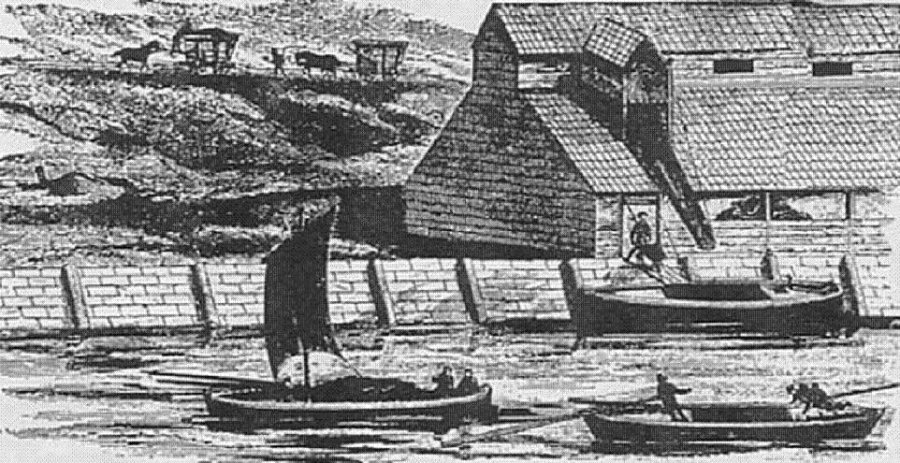History
The area around The Waggon Inn and The Waggon Inn itself is steeped in history, so here is the first of what I hope is a series of articles about the area, its people and its history.
I thought the best way to start would be to describe just what Waggons and Waggonways are all about.
The Waggonway and How it Developed
Around 1568, German miners working in the Mines Royal near Keswick had knowledge of tub railways, as archaeological work at the Mines Royal site at Caldbeck in the English Lake District has now confirmed the use of “hunds”, as track fragments have been found.The wooden tubs, known as “hunds” (“dog” in German) ran on two wide boards or rails and were used to move ore within the mines. These hunds used a guide pin system, utilising the slot between the two board rails to keep them on course.
The first true railways, using a flange to keep the wheel on a rail, were developed in the early 17th century. In 1604, Huntingdon Beaumont completed the Wollaton Wagonnway, built to transport coal from the mines at Strelley to Wollaton Lane End, just west of Nottingham, England. Wagonways have been proven to exist between Broseley and Jackfield in Shropshire from 1605, used by James Clifford to transport coal from his mines in Broseley to the River Severn. It has recently been suggested that these are somewhat older than that at Wollaton.
Wagonnways improved coal transport by allowing one horse to deliver between 10 to 13 long tons of coal per run— an approximate fourfold increase. Wagonnways were usually designed to carry the fully loaded wagons downhill to a canal or boat dock and then return the empty wagons back to the mine.
Until the beginning of the Industrial Revolution, the rails were made of wood, were a few inches wide and were fastened down, end to end, on logs of wood or “sleepers”, placed crosswise at intervals of two or three feet. In time, it became a common practice to cover them with a thin flat sheathing or “plating” of iron, in order to add to their life and reduce friction. This caused more wear on the wooden rollers of the wagons and towards the middle of the 18th century, led to the introduction of iron wheels, the use of which is recorded on a wooden railway near Bath in 1734. However, the iron sheathing was not strong enough to resist buckling under the passage of the loaded wagons, so rails made wholly of iron were invented.
See the Only Rope Hauled Railway in the World – Near The Waggon Inn!
Bowes Railway was originally a colliery railway built to carry coal mainly from pits in north west Durham to the Tyne at Jarrow. The earliest section was designed by George Stephenson and opened on 17 January 1826, making it one of the world’s first modern railways.
It was 15 miles long when completed in 1855. Each end was locomotive worked; the six mile middle section consisting of rope worked inclines with very steep gradients. At its peak, the Railway handled over 1 million tons of coal per year and remained virtually intact until 1968.
Between 1968 and 1974, most of the line was closed until only the last 3.5 miles between Monkton and Jarrow staithes were operated by the National Coal Board. However, the original 1826 section between the Black Fell bank head and Springwell bank head was acquired for preservation in 1976 by Tyne and Wear County Council.
Between 1968 and 1974, most of the line was closed until only the last 3.5 miles between Monkton and Jarrow staithes were operated by the National Coal Board. However, the original 1826 section between the Black Fell bank head and Springwell bank head was acquired for preservation in 1976 by Tyne and Wear County Council.
This comprises Blackham’s Hill West and East inclines, which are operated by a stationary haulage engine. It is the only working preserved standard gauge rope hauled railway in the world. In 1977, the Railway’s Engineering and Wagon Shops at Springwell were added to the scheme, providing the facilities needed for maintenance.
Information kindly supplied by http://suscram.weebly.com/bowes-railway.html
Local Waggonways – A Brief History
Ouston and Pelaw Waggonway – also known as the Pelaw Main Railway, this waggonway is thought to have started in 1809 or 1810. Rope haulage was used from the pits at Urpeth, passing the Three Tuns on the Great North Road in Birtley. The 1862 Ordnance Survey map shows an Old Engine near the Lamb Pit above Birtley. An 1812 map show the coal going down from there via Oxclose to the River Wear at Washington. By 1815 a new route from Urpeth NZ2554 and Ouston passed the William IV in Birtley. Hauling engines were at Blackfell and Eighton Banks. It is thought that rope haulage was used on the level section to White Hill NZ2760.
A branch from pits in the Team Valley joined at White Hill. There was a hauling engine at Team Colliery where the waggonway passed under the A167 New Durham Road NZ2658. Another hauling engine was near the Seven Stars NZ2759 in Wrekenton where Gateshead Electric Tramways crossed the waggonway until 1951. Locomotives were later used to haul coal up the steep inclines from Team Valley. The locomotive shed was at Team Colliery, on the opposite side of the A167 New Durham Road to where the Angel of the North now stands.
From White Hill a self-acting incline ran down to Heworth. The waggonway then crossed Sunderland Road on the way to Pelaw Main Staiths NZ3063. Level crossing gates caused traffic congestion on this once main road, now the B1426. The A184 Felling bypass was built in 1959 with a bridge over the waggonway. The self-acting incline closed soon after. Coal from the Team Valley then reversed at White Hill and went on a curve to the Bowes Railway NZ2858. This curve is still used for passenger trains by the Bowes Railway Museum. The lines were nationalised in 1947 and became part of the National Coal Board.
Why Waggonways Were a Key Economic Factor in the North East’s History
Waggonways were the outcome of the early coal barons wanting to find a faster way to transport coal form the pit-head to the ships for transportation. The proximity of the North East mines to shipping ports meant that they had a significant advantage over other coal producing areas in the UK and could ship the coal to nearby staithes in Tyne and Wear. The early forms of moving coal from the pits – horse and cart or ox and cart using poor roadways was slow and the roads often impassable.
The Waggonway consisted of a wooden railway that sloped down to the staithes. The vehicles used to carry the coals – the waggons – held up to three tons of coal and were hauled by horse under the control of of the waggoner, the designated driver. This system was first introduced in the 17th century, being replaced in the 19th century with metal waggons instead of the wooden ones and the horsepower being provided by steam engines that used a rope pulley system to haul the waggons.
What Does a Waggon Look Like?
Our new logo was drawn from a preserved Waggon at Beamish and gives you an idea of just what the early Waggons looked like.
A typical early waggon or wain was usually made of wood with a carrying capacity of 2 -3 tons of coal. The four wheels were of one-piece metal construction with flanges to help them seat on the waggonway rails more efficiently and a rudimentary braking system – usually a lever that applied friction to one or two of the wheels – controlled the descent of the waggon to the staithes. Coal was delivered to the ship or transfer boat – an oar powered keel, hence the song ‘Weel may the Keel Row’ (see below)’ – through a trapdoor under the waggon.
Weel May the Keel Row
As I came thro’ Sandgate,
Thro’ Sandgate, thro’ Sandgate,
As I came thro’ Sandgate,
I heard a lassie sing:
“O, weel may the keel row,
The keel row, the keel row,
O weel may the keel row
That my laddie’s in.”
“O wha’s like my Johnnie,
Sae leish, sae blithe, sae bonnie?
He’s foremost ‘mang the mony
Keel lads o’ coaly Tyne;
He’ll set or row sae tightly
Or, in the dance sae sprightly,
He’ll cut and shuffle slightly,
‘Tis true, were he nae mine.
He wears a blue bonnet,
Blue bonnet, blue bonnet,
He wears a blue bonnet
A dimple in his chin.
And weel may the keel row,
The keel row, the keel row,
And weel may the keel row
That my laddie’s in.”
Note: a keel is a boat; leish is lithe. The song was first published around 1770, and has been called the national anthem of
the Tyne River.
Pic Keel Boats and Horse Drawn Waggons at Lambton staiths c. 1790 Keel Boats were shallow draught boats with oars or poles, about 40 ft. long, with both ends pointed, which used the tides or a sail to take the coal to the waiting ships. In the background you can see the horse drawn Waggons ascending and descending.



